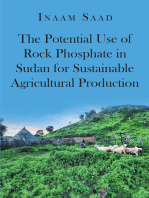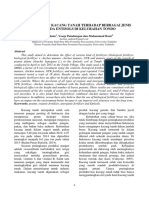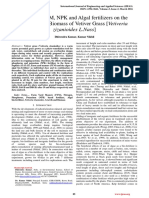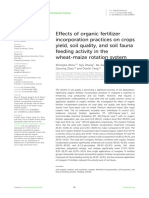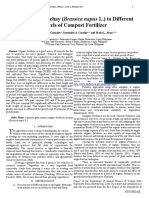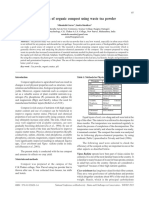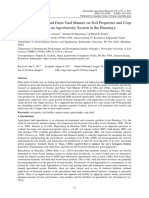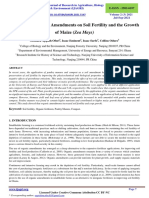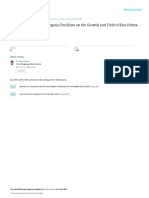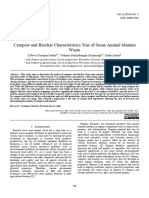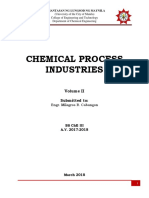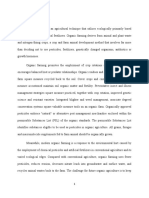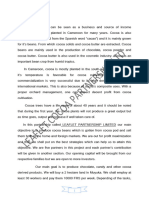Professional Documents
Culture Documents
Influence of Organic Fertilizer Application On Soil Nutrients and Yield of Cotton
Original Title
Copyright
Available Formats
Share this document
Did you find this document useful?
Is this content inappropriate?
Report this DocumentCopyright:
Available Formats
Influence of Organic Fertilizer Application On Soil Nutrients and Yield of Cotton
Copyright:
Available Formats
Volume 9, Issue 1, January 2024 International Journal of Innovative Science and Research Technology
ISSN No:-2456-2165
Influence of Organic Fertilizer Application on Soil
Nutrients and Yield of Cotton
Dr. Kamrul Hassan Dr. Sima Kundu Dr. Md. Fakre Alam Ibne Tabib
Deputy Director Project Director Executive Director
Cotton Development Board Cotton Development Board Cotton Development Board
Jashore, Bangladesh Dhaka, Bangladesh Dhaka, Bangladesh
Abstract:- The study was conducted to evaluate the there are problems with high frequency of chemical
performance of organic fertilizers on cotton yield and fertilizer application and less use of organic fertilizers
soil nutrients at Cotton Research Farm of Cotton (Chen et al., 2017). Organic fertilizer is the source of soil
Development Board located at Jagodishpur, organic carbon and soil organic carbon is an important
Chawgacha, Jashore during the crop growing season of indicator of soil health, particularly impacts on soil fertility
2021 and 2022 using the seeds of genotype CB Hybrid-1 for crops, because it has several benefits: improving soil
planted in a spacing of 90 × 35 cm. The experiment was structure through soil particle aggregation enabling better
laid out in a RCBD design with three replications. The root access, increased water infiltration and retention,
experimental treatments were consisted of different increased nutrient bioavailability due to soil organic matter
doses of cow dung and processed organic fertilizers of decomposition and more exchange sites for mineral
three different sources (a, b and c). The treatments nutrients increasing the soil’s cation exchange capacity.
were: T1 = control (zero fertilizer), T2 = 10.526 t ha-1 of Many studies have shown that applying organic fertilizers
cow dung, T3 = 3.571 t ha-1 of processed organic to the soil surface can provide a rich food source for
fertilizer (a), T4 = 4.225 t ha-1 of processed organic microorganisms and significantly increase microbial
fertilizer (b), T5 = 5.0 t ha-1 of processed organic community composition and diversity compared to no
fertilizer (c), T6 = ½ cow dung + ½ recommended application (Chang et al., 2007; Diacono and Montemurro,
fertilizer dose (RFD) of N, P, K, S, B, Zn and Mg, T7 = 2010).
½ (a) + ½ RFD of N, P, K, S, B, Zn and Mg, T8 = ½ (b) +
½ RFD of N, P, K, S, B, Zn and Mg and T9 = ½ (c) + ½ Mineral fertilizers, particularly nitrogen, phosphorus
RFD of N, P, K, S, B, Zn and Mg. The trend of nutrients and potassium (NPK), are widely used in intensive arable
was smaller but increase was observed. The highest farming, but at present organic fertilizers are not common
increase of total OM, total N, P, K, S, Zn and B were in Bangladesh. Furthermore, crop straw is removed from
7.89%, 10.0%, 8.27%, 9.09%, 9.0%, 8.81%, 8.33% agricultural farms and cow dung is burned as homestead
respectively and those were recorded in T5, T2, T6, T3, fuel. Chemical fertilizers are widely used in agricultural
T7, T7 and T5 treatments respectively in the end of production practices. The use of large amounts of chemical
second year. The results indicated that the half amount fertilizers has a series of harmful ecological and
of organic fertilizer (b) along with ½ RFD (T8) produced environmental impacts, such as soil acidification, soil
the maximum seed cotton (2.49 t/ha) in 2021. But sole compaction, and soil fertility degradation, which severely
organic fertilizer at the rate of 4.225 t ha-1 (source- b) restrict the sustainable development of green agriculture
produced maximum seed cotton (2.51 t/ha) in 2022. (Chen et al., 2017 and Gosal et al., 2018).
Amendment of sole cow dung gave maximum BCR of
2.34 and 2.69 in 2021 and 2022 respectively. The Cotton, an important fiber crop, is cultivated widely in
treatments T3, T6, T7 and T8 might be the optimum tropical and sub-tropical regions, which play an important
treatment on the basis of BCR. Application of organic role in the national economy of Bangladesh. It occupies
fertilizer with inorganic offers higher yield of seed about 50,000 hectares of the cultivated land of the country.
cotton and economic returns with an increase of soil The farmers are generally subsistence small holders with
nutrients. poor knowledge of fertilizer management (FAO, 2015).
Now a days, most of the farmers in Bangladesh use high
Keywords:- Amendment, Fertilizer, Increase, Nutrient, yielding varieties and consequently it requires more
Organic. fertilizer application. Although farmers are willing to use
more N fertilizer for a better crop yield. The lower yield of
I. INTRODUCTION cotton with association of inorganic fertilizers is one of the
challenge for farmers. A very few farmers are using
Application of organic and inorganic fertilizers different processed organic fertilizers as the substitute of
increase the accumulation of C, N, and P in the soil and cow dung or farmyard manure along with inorganic
improve the soil’s ability to supply nutrients to crops (Ma fertilizers in cotton cultivation. Organic fertilizers or
et al., 2009). Fertilizers are used to increase soil fertility manures release nitrogen, potassium, phosphorus and other
and it contribute a lot in food production and food security nutrient elements to the soil. In cotton nitrogen encourages
(Choudhary et al., 2021 and Wang et al., 2021). However, vegetative growth and boll setting by increasing sympodial
IJISRT24JAN781 www.ijisrt.com 1214
Volume 9, Issue 1, January 2024 International Journal of Innovative Science and Research Technology
ISSN No:-2456-2165
branches and boll weight. But nitrogen can be reduced S, B, Zn and Mg, T7 = 1/2 (a) + 1/2 RFD of N, P, K, S, B,
yield and quality of cotton to have excess nitrogen in late Zn and Mg, T8 = 1/2 (b) + 1/2 RFD of N, P, K, S, B, Zn and
reproductive stage (Luo et al., 2018). Therefore, rationally Mg and T9 = 1/2 (c) + 1/2 RFD of N, P, K, S, B, Zn and
balancing organic and chemical fertilizer input and Mg. The experiment was laid out in a RCBD design with
enhancing crop yields and soil sustainability are the targets three replications. RFD is the recommended fertilizer dose
that need to be focused urgently in current cotton at the rate of 60 (reduced), 75, 205 , 25, 2, 3.3 and 1.8 kg N,
cultivation practices. The effect of organic fertilizers on P, K, S, B, Zn and Mg ha-1 respectively in the form of Urea,
cotton yield and soil nutrient has not been studied TSP, MoP, Gypsum, Borax, Zinc sulfate and Magnesium
extensively. The aim of this experiment was to investigate sulfate. The seeds of cotton genotype CB Hybrid-1 were
the effects of applying different organic fertilizers on cotton sown maintaining a spacing of 90 cm x 35 cm. All other
yield and soil nutrient. required cultural operations regarding weeding and plant
protection measures were adopted uniformly in all the plots
II. MATERIALS AND METHODS throughout the growing periods. Irrigation was done on first
week of November and last week of November. Soil
The experiment was conducted to evaluate the yield samples were collected initially in 2021 and in the end of
contributing parameters of cotton and soil nutrients as seed cotton harvest in 2022 to analyze nutrient status of the
affected by organic fertilizers during 2021 and 2022 at soil. Organic carbon in the soil sample was determined by
Cotton Research, Training and Seed Multiplication Farm, wet oxidation method of Walkley and Black (1965). Total
Jagodishpur, Chowgacha, Jashore. The experimental site N content of soil was determined following Kjeldahl
was gangetic alluvium soil with sandy loam textured. A method as outlined by Jackson (1973). Available P content
description of air temperature and rainfall is presented in of soil was extracted from the soil with 0.5M NaHCO3
Table 1. The monthly mean maximum temperature of 34 0C solution at pH 8.5 (Olsen et al., 1954). The P in the extract
was recorded in the month of July and the monthly mean was then determined by developing blue color measuring
minimum temperature of 16.7 0C was found in the month of the color by spectrophotometer at 660 nm wave length. K
December in the crop growing season 2021. The monthly was determined from the extract (extraction with 1M
mean maximum temperature of 35.6 0C was recorded in the ammonium acetate) using a flame photometer (Black,
month of August and the monthly mean minimum 1965). The S content in the extract (extracting soil sample
temperature of 15.0 0C was found in the month of with 0.15% CaCl2 solution as described by Page et al.,1982
December in the crop growing season 2022. The crop and S was determined turbidimeterically, the turbid was
received total rain fall of 1151 mm in 2021 and 561 mm in measured by a spectrophotometer. The available B content
2022. Cow dung and processed organic fertilizers were of soil was extracted by hot water and extractable B was
used in the study. The sources of processed organic determined by azomethene-H method. The absorbance of B
fertilizers were a) Soil Tech Agro Organic Fertilizer; b) was measured at 420 nm on a spectrophotometer and
NAAFCO (Pvt.) Limited and c) Advanced Chemical calculated by using a standard curve (Petersen, 1999). Data
Industries (Ltd.). The experiment comprised of nine on total biomass (not presented) and yield contributing
treatments: T1 = 0.0 kg ha-1 organic and inorganic fertilizer parameters were recorded during seed cotton harvest. Data
(control), T2 = 10.526 t ha-1 cow dung (N = 60 kg ha-1), T3 = for the studied characters were statistically analyzed.
3.571 t ha-1 processed (a) organic fertilizer (N = 60 kg ha-1), Duncan’s multiple range test (DMRT) was used to
T4 = 4.225 t ha-1 processed (b) organic fertilizer (N = 60 kg determine the significant differences at 5% level of
ha-1), T5 = 5.0 t ha-1 processed (c) organic fertilizer (N = 60 significance.
kg ha-1), T6 = 5.263 t ha-1 cow dung + 1/2 RFD of N, P, K,
Table 1: Air temperature and rainfall data during crop growing season 2021 and 2022
Month Minimum mean temperature (0C) Maximum mean temperature (0C) Rainfall (mm)
2021 2022 2021 2022 2021 2022
July 26.8 26.6 34.0 35.0 269 74
August 27.0 26.8 33.6 35.6 247 215
September 26.3 26.8 32.6 34.2 287 162
October 26.0 27.4 33.4 33.7 151 110
November 17.7 17.4 29.6 30.2 38 -
December 16.7 15.0 25.6 26.4 159 -
Source: Bangladesh Metrological Department
III. RESULTS AND DISCUSSIONS treatment (T1) organic matter (OM) was not changed. OM
was increased highest of 7.89 % in T5 treatment over the
The effect of different organic fertilizers on soil baseline year. The initial total N was recorded highest of
nutrient was determined. The nutrient status of the 0.071% in T7 treatment and the highest increase of total N
experimental plots in the baseline year 2021 (initial) and in of 10% was recorded in T2 treatment in the end of second
the end of crop growing season 2022 are presented in Table year. The trend of available P was found increased with the
2. The nutrient elements of the studied plots were found highest increase of 8.27% over the baseline year in T 6
similar in the baseline year 2021 and in 2022. In the control treatment and the highest average of P was 11.42 µg/g soil
IJISRT24JAN781 www.ijisrt.com 1215
Volume 9, Issue 1, January 2024 International Journal of Innovative Science and Research Technology
ISSN No:-2456-2165
in T9 treatment. K was determined highest of 2.29 Performance of yield traits of cotton: Yield
m.e./100g soil in T6 treatment in the baseline year and in contributing characters of cotton have been evaluated in
2022. K was decreased in the control treatment in 2022 and this experiment during 2021 and 2022. Mean squares of
the increase was determined highest of 9.09% over the yield traits of cotton under different organic fertilizers are
baseline year in T3. The available S was observed highest presented in Table 3. The parameters viz. number of bolls
of 17.55 µg/g soil in T6 and T9 treatment in the baseline palnt-1 and yield were highly significant, but single boll
year and the highest increase of 9% was observed in T 7 weight found insignificant among treatments in 2021. The
treatment in the end of second year. The available Zn of results also shows that the number of bolls palnt-1, single
2.45 µg/g soil was similar in the baseline year and in 2022 boll weight and yield were highly significant among
in control treatment and it was increased highest of 8.81% treatments in 2022.
in T7. The available B was decreased in T1 and T7 treatment
and the highest increase of 8.33% was found in T5 over the
base line year. Similar benefit of using manures in the soil
are reported by Cathy et al., 2019.
Table 2: Effect of different organic and inorganic fertilizers on soil nutrient
Amount of soil nutrient elements under different treatments
Season
Nutrient T1 T2 T3 T4 T5 T6 T7 T8 T9
initial 0.64 0.54 0.64 0.53 0.38 0.88 1.02 1.16 0.56
OM (%) 2022 0.64 0.58 0.68 0.55 0.41 0.9 1.06 1.15 0.59
increase
0.00% 7.41% 6.25% 3.77% 7.89% 2.27% 3.92% -0.86% 5.36%
(%)
average 0.64 0.56 0.66 0.54 0.395 0.89 1.04 1.155 0.575
initial 0.037 0.03 0.037 0.035 0.022 0.052 0.071 0.052 0.057
2022 0.03 0.033 0.039 0.038 0.021 0.054 0.073 0.054 0.057
Total N
(%) increase
-18.92% 10.00% 5.41% 8.57% -4.55% 3.85% 2.82% 3.85% 0.00%
(%)
average 0.0335 0.0315 0.038 0.0365 0.0215 0.053 0.072 0.053 0.057
initial 7.63 7.63 7.29 8.45 10.34 10.16 8.86 7.55 11.32
2022 7.29 8.01 7.61 8.69 10.75 11 9.01 7.86 11.52
P (µg/g)
increase
-4.46% 4.98% 4.39% 2.84% 3.97% 8.27% 1.69% 4.11% 1.77%
(%)
average 7.46 7.82 7.45 8.57 10.545 10.58 8.935 7.705 11.42
initial 0.27 0.22 0.22 0.24 0.27 0.29 0.24 0.23 0.26
K 2022 0.25 0.23 0.24 0.24 0.28 0.29 0.26 0.24 0.28
(m.e./100g) increase
-7.41% 4.55% 9.09% 0.00% 3.70% 0.00% 8.33% 4.35% 7.69%
(%)
average 0.26 0.225 0.23 0.24 0.275 0.29 0.25 0.235 0.27
initial 16 15.95 15 15.95 14.15 17.55 17 15.5 17.55
2022 15.7 16 16 17.05 15.35 19 18.53 16.31 18.95
S (µg/g)
increase
-1.88% 0.31% 6.67% 6.90% 8.48% 8.26% 9.00% 5.23% 7.98%
(%)
average 15.85 15.975 15.5 16.5 14.75 18.275 17.765 15.905 18.25
initial 2.45 2.88 2.89 2.23 3.45 3.45 2.27 2.65 3.21
Zn (µg/g) 2022 2.45 2.91 2.95 2.35 3.51 3.51 2.47 2.88 3.39
increase
0.00% 1.04% 2.08% 5.38% 1.74% 1.74% 8.81% 8.68% 5.61%
(%)
average 2.45 2.895 2.92 2.29 3.48 3.48 2.3 2.765 3.3
initial 0.94 0.86 0.87 0.93 0.72 1.28 1.25 0.95 0.89
2022 0.91 0.91 0.9 0.98 0.78 1.32 1.22 1.02 0.93
B (µg/g)
increase
-3.19% 5.81% 3.45% 5.38% 8.33% 3.13% -2.40% 7.37% 4.49%
(%)
average 0.925 0.885 0.885 0.955 0.75 1.3 1.235 0.985 0.91
IJISRT24JAN781 www.ijisrt.com 1216
Volume 9, Issue 1, January 2024 International Journal of Innovative Science and Research Technology
ISSN No:-2456-2165
Results in Fig. 1 and Fig. 2 showed that the number of highest in T4 (22.1) treatment (amendment by processed
bolls plant-1 was increased over control treatments due to organic fertilizer, b). While the highest number of boll per
application of fertilizers in 2021 and 2022. The T8 treatment plant was recorded from 70% inorganic N with 30% N
produced the highest number of bolls plant-1 (20.8) which from poultry manure by Islam et al. (2014) and from
was statistically similar with those observed in treatments amendment of FYM @ 5t/ha with RFD by Sathya et al.
T4, T6, T7 and T9 in 2021. But in 2022, the highest number (2022) which was consistent with our results. Data
of bolls plant-1 of 23.5 was observed in the treatment T4 presented in Fig. 1 also indicated that the highest boll
which was statistically different from all other treatments. weight of 4.76 g was found in the treatment T6 followed by
The second highest bolls were produced in T9 which was T7. On the other hand, the lowest boll weight of 4.19 g was
statistically similar with those treatments observed in T6, T7 in the treatment T1 in 2021. But the T3 treatment produced
and T8. The average boll of 2021 and 2022 was found the highest weight (4.98) of a single boll in 2022.
Table 3: Mean square values of different agronomic and yield parameters of cotton under different organic fertilizer treatment at
Jagodishpur during 20221 and 2022
Year Source df No. of bolls plant-1 Single boll weight Yield
2021 Replication 2 45.704 0.143 269520
Treatment 8 43.021** 0.057NS 822430**
Error 16 8.802 0.042 89893
2022 Replication 2 1.400 0.038 23374
Treatment 8 64.746** 0.120** 844562**
Error 16 1.012 0.024 92066
** = significant at p ≤ 0.01; * = significant at p ≤ 0.05, NS = Not significant at p ≤ 0.05
Cotton yield is a complex character which depends on in terms of seed cotton yield and T8 yielded 39% higher
several individual traits such as no. of bolls plant -1, single over control treatment in 2021. The results of 2022
boll weight, plant height etc. The higher boll weight and indicated that after amendment of soil, seed cotton yield
boll numbers are considered to be the indication of higher was increased in most of the treatments. The highest yield
seed cotton yield. In our experiment seed cotton yield was increased of 15.23% was recorded in T2 treatment and the
significantly (p < 0.01) varied among treatments and it second highest increased of 12.62% in T5 treatment over the
ranged from 1.04 to 2.49 t ha-1 in 2021 and 1.0 to 2.51 t ha-1 yield of 2021 at the end of 2022 and the yield was
in 2022. The highest yield of 2.49 was observed in the decreased (3.85%) in the control treatment (Fig. 3). The
treatment T8 in 2021 (Fig. 1) and 2.51 t ha-1 in T4 in the treatments were ranked in the order of T4 > T8 > T5 > T9 >
crop growing season 2022 (Fig. 2). The treatments may be T2 > T7 > T3 > T6 > T1 based on seed cotton yield in 2022.
ranked in order of T8 > T4 > T3 = T7 > T9 > T5 > T6 > T2 > T1
Fig. 1: Effect of organic fertilizers yield attributes of cotton in 2021
IJISRT24JAN781 www.ijisrt.com 1217
Volume 9, Issue 1, January 2024 International Journal of Innovative Science and Research Technology
ISSN No:-2456-2165
Fig. 2: Effect of organic fertilizers on yield attributes of cotton in 2022
Fig. 3: Change in yield (%) as influenced by organic fertilizers in 22022
In previous results by Sathya et al. (2022), Tagaev et IV. ECONOMICS
al. (2022) and Niu et al. (2021) were consistent with our
results that application of organic fertilizers with inorganic The maximum gross return of cotton production was
fertilizers increased seed cotton yield. Application of from T4 treatment (Tk. 238450/-) followed by from T1
optimum N improves various physiological and metabolic (Tk.95000/-) in 2022 (Table 4). In 2021, the maximum
processes such as photosynthesis, carbon, and nitrogen gross return obtained from T8 (236550/-) and the lowest
metabolism, which is an important factor of high yield and from T1 (Tk.98800/-). The gross margin was obtained
high quality of cotton. Boquet and Breitenbeck (2000) also highest from T2 (Tk. 135723/-) followed by T8 (Tk.
concluded that the application of N fertilizer is one of the 128975/-) and the lowest from T1 (Tk. 36125/-) in 2022.
important means to increase cotton yield. Many studies The gross margin also fond maximum from T8 (128025/-)
have confirmed that a reasonable supply of N nutrition can in 2021. The maximum benefit cost ratio was found in T 2
increase the dry matter and growth rate of cotton at all (2.69) season 2021, the BCR was highest in T 2 (2.34) and
stages (Xue et al., 2006). In our study N was applied @ 60 lowest was in T5 treatment (1.46). The treatments T3, T6, T7
kg/ha (from sole organic fertilizer) and yield was found and T8 also shows the optimum BCR (> 2.0).
increased over control.
IJISRT24JAN781 www.ijisrt.com 1218
Volume 9, Issue 1, January 2024 International Journal of Innovative Science and Research Technology
ISSN No:-2456-2165
V. CONCLUSION end of second year, the highest increase of total OM, total
N, P, K, S, Zn and B were 7.89%, 10.0%, 8.27%, 9.09%,
Application of organic fertilizers in different doses 9.0%, 8.81%, 8.33% recorded respectively and those
and application with chemical fertilizers had a contribution increases of elements observed in T5, T2, T6, T3, T7, T7 and
to increase soil nutrients and seed cotton yield. The trend of T5 treatments respectively. The half amount
nutrients were similar but an increase was observed. In the
Table 4: Benefit cost analysis of cotton production with the application of organic fertilizer in 2021 and 2002.
Treatment Gross Cost of Total cost of Gross Benefit-
yield
Season return treatment cultivation margin cost ratio
(t/ha)
(Tk. ha-1) (Tk./ha) (Tk. /ha) (Tk./ha) (BCR)
2021 1.04 98800 0 39925 1.68
T1 2022 1 95000 58875 36125 1.61
2021 1.97 187150 107163 2.34
T2 2022 2.27 215650 21052 79927 135723 2.69
2021 2.19 208050 104537 2.01
T3 2022 2.19 208050 44638 103513 104537 2.01
2021 2.47 234650 108175 1.86
T4 2022 2.51 238450 67600 126475 111975 1.89
2021 2.06 195700 61825 1.46
T5 2022 2.32 220400 75000 133875 86525 1.65
2021 2.03 192850 107599 2.26
T6 2022 2.08 197600 26376 85251 112349 2.32
2021 2.19 208050 111006 2.14
T7 2022 2.22 210900 38169 97044 113865 2.17
2021 2.49 236550 128025 2.18
T8 2022 2.5 237500 49650 108525 128975 2.19
2021 2.13 202350 90125 1.8
T9 2022 2.28 216600 53350 112225 104375 1.93
T1 = Control, T2 = 10.526 t ha-1 cow dung, T3 = 3.571 REFERENCES
t ha-1 processed (a) organic fertilizer, T4 = 4.225 t ha-1
processed (b) organic fertilizer, T5 = 5.0 t ha-1 processed (c) [1]. C.A. Black, “Method of soil analysis part 1 and 2,”
organic fertilizer, T6 = 5.263 t ha-1 cow dung + 1/2 RFD of Amer. Soc. Agron. Inc. Pub. Madison, Wisconsin,
N, P, K, S, B, Zn and Mg, T7 = 1/2 (a) + 1/2 RFD of N, P, USA, 1965.
K, S, B, Zn and Mg, T8 = 1/2 (b) + 1/2 RFD of N, P, K, S, [2]. D.J. Boquet and G.A. Breitenbeck, “Nitrogen rate
B, Zn and Mg, T9 = 1/2 (c) + 1/2 RFD of N, P, K, S, B, Zn effect on partitioning of nitrogen and dry matter by
and Mg Cost: Cow dung: 2000 Tk/t; Organic fertilizer (a): cotton,” Crop Sci, 2000, vol. 40, pp. 1685–1693.
12500 Tk./t; (b): 16000 Tk/t; (c): 15000 Tk/t Urea: 18000 [3]. L.T. Cathy, G.E. Acquah, A.P. Whitmore, S.P.
Tk/t; TSP: 24000 Tk/t; MoP: 1800 Tk/t; Gypsum: 35000 McGrath and S.M. Haefele, “The effect of different
Tk/t, Zinc sulfate: 220000 Tk/t; Magnesium sulfate: 50000 organic fertilizers on yield and soil and crop nutrient
Tk/t; Borax: 300000 Tk/t; Basic cost of cultivation: 58875 concentrations,” Agronomy, 2019,
Tk/ha. Price of seed cotton: 95 Tk /kg of organic fertilizer doi:10.3390/agronomy 9120776.
(b) along with ½ RFD (T8) produced the maximum seed [4]. E. H. Chang, R. S. Chung and Y. H. Tsai, “Effect of
cotton (2.49 t/ha) in 2021. But sole organic fertilizer ‘b’ different P application rates of organic fertilizer on
produced maximum seed cotton (2.51 t/ha) in 2022. soil enzyme activity and microbial population,” Soil
Amendment of sole cow dung gave maximum BCR of 2.34 Sci. Plant Nutr, 2007, vol. 53 (2), pp. 132–140.
and 2.69 in 2021 and 2022 respectively. But the treatments [5]. D. Chen, L. Yuan, Y. Liu, J. Ji and H. Hou, “Long-
T3, T6, T7 and T8 might be the optimum treatment on the term application of manures plus chemical fertilizers
basis of BCR as their BCR is more than 2.0. From our sustained high rice yield and improved soil chemical
results it can be concluded that application of organic and bacterial properties,” Eur. J. Agron, 2017, vol. 90,
fertilizer with inorganic offers higher yield of seed cotton pp. 34–42.
and economic returns with small increases of soil nutrients.. [6]. M. Choudhary, V.S. Meena, S.C. Panday, T. Mondal,
R.P. Yadav, P.K. Mishra, J.K. Bist and A. Pattanayak,
“Long-term effects of organic manure and inorganic
fertilization on biological soil quality indicators of
soybean-wheat rotation in the Indian mid-Himalaya,”
2021, Appl. Soil Ecol, Vol. 157, pp. 103754.
IJISRT24JAN781 www.ijisrt.com 1219
Volume 9, Issue 1, January 2024 International Journal of Innovative Science and Research Technology
ISSN No:-2456-2165
[7]. M. Diacono and F. Montemurro, “Long-term effects [21]. Y. Wang, S.L. Bauke, C.V. Sperber, F. Tamburini, J.
of organic amendments on soil fertility,” A review. Guigue, P. Winkler, K. Kaiser, B. Honermeier and W.
Agron. Sustain. Dev. 2010, Vol. 30 (2), pp. 401–422. Amelung, “Soil phosphorus cycling is modified by
[8]. FAO, Food and Agricultural Organization of the carbon and nitrogen fertilization in a long-term field
United Nations, “The economic lives of smallholder experiment,” J. Plant Nutr. Soil Sci., 2021,
farmers,” 2015. FAO, Rome, Italy. doi: 10.1002/jpln.202000261.
[9]. S.K. Gosal, G.K. Gill, S. Sharma and S.S. Walia, [22]. X.P. Xue, J.G. Wang, W.Q. Guo, B.L. Chen, J. You
“Soil nutrient status and yield of rice as affected by and Z.G. Zhou, “Effect of nitrogen applied levels on
long-term integrated use of organic and inorganic the dynamics of biomass, nitrogen accumulation and
fertilizers,” 2018, J. Plant Nutr, vol. 41, pp. 539–544. nitrogen fertilization recovery rate of cotton after
[10]. M.K. Islam, Khalequzzaman, K. Hassan and M. initial flowering,” Acta Ecol. Sin., 2006, vol. 26, pp.
Kaikobad, “Effect of Organic and Inorganic source of 3632–3640.
N on Cotton Yield,” Annual Research Report
Congress, Cotton Development Board, Bangladesh,
2014, pp. 131-141.
[11]. M.N. Jackson, Soil Chemical Analysis, Prentic Hall of
India Pvt. Ltd. New Delhi, India,1973.
[12]. Z. Luo, H. Liu, W.P. Li, Q. Zhao, J.L. Dai, L.W. Tian
and H.Z. Dong, “Effects of reduced nitrogen rate on
cotton yield and nitrogen use efficiency as mediated
by application mode or plant density,” Field Crop
Res., 2018, vol. 218, pp. 150–157.
[13]. Y. Ma, J. Li, X. Li, X. Tang, Y. Liang, S. Huang, B.
Wang, H. Liu and X. Yang, “Phosphorus
accumulation and depletion in soils in wheat-maize
cropping systems: Modeling and validation,” Field
Crop Res., 2009, vol. 110, pp. 207–212.
[14]. J. Niu, G. Huiping, A. Iqbal, H. Zhang, Q. Dong, N.
Pang, S. Wang, Z. Wang, X. Wang, G. Yang and M.
Song., “N-Use Efficiency and Yield of Cotton (G.
hirsutumn L.) are improved through the combination
of N-fertilizer reduction and N-efficient cultivar,:
Agronomy, 2021, vol. 11, pp. 55.
[15]. M.S.R. Olsen, C.U. Cole, F.S. Watanable and L.A.
Deun, “Estimation of available phosphorus in soil
extraction with sodium bicarbonate” US Agricultural
Criticism, 1954, pp. 929.
[16]. A.L. Page, R.H. Miller and D.R. Keeney (Eds.),
“Methods of Soil Analysis. Part.-2.Chemical
microbiological properties. 2nd edition
American Society of Agronomy, Inc., Soil
Science Societ y of American Inc,” Madison,
Wisconsin USA, 1982, pp. 403-430.
[17]. L. Petersen, “Soil Analytical Methods,” Soil Testing,
Management and Development of SRDI Project. Soil
Resource Development Institute, Dhaka, 1999.
[18]. S. Sathya, N. Akila, M. Thirunavukkarasu and B.
Kalaiselvi, “Yield and available nutrient status as
influenced by nutrient management practices in
cotton,” J Krishi Vigyan, vol. 11 (1), pp. 406-409.
[19]. A.M. Tagaev, N.M. Daurenbek and Sh.O.
Bastaubaeva, “The effect of bio-fertilizers on cotton
productivity and quality,” IPO Conf. series, Earth and
environmental Science, 2022, 1043 012055.
[20]. A. Walkley and C. A. Black, “An examination of
digestion method for determining soils organic matter
and a proposed modification of the chromic acid
titration method,” Soil Science, 1965, vol. 37, pp. 29-
38.
IJISRT24JAN781 www.ijisrt.com 1220
You might also like
- Biocharculture Biochar for Environment and DevelopmentFrom EverandBiocharculture Biochar for Environment and DevelopmentNo ratings yet
- The Potential Use of Rock Phosphate in Sudan for Sustainable Agricultural ProductionFrom EverandThe Potential Use of Rock Phosphate in Sudan for Sustainable Agricultural ProductionNo ratings yet
- Admin,+4.+62-65 Sumantra Reduction Paddy+EditedDocument4 pagesAdmin,+4.+62-65 Sumantra Reduction Paddy+EditedthobisudahkuliahNo ratings yet
- Yield and Nutrient Status of Wheat Plants (Triticum Aestivum) As Affected by Sludge, Compost, and Biofertilizers Under Newly Reclaimed SoilDocument6 pagesYield and Nutrient Status of Wheat Plants (Triticum Aestivum) As Affected by Sludge, Compost, and Biofertilizers Under Newly Reclaimed SoilNaztovenNo ratings yet
- T ViridaeDocument8 pagesT ViridaedonbosskissNo ratings yet
- Nano Zinc and RiceDocument6 pagesNano Zinc and RiceRamprakash tataNo ratings yet
- Full Paper - Isaias - ALDocument7 pagesFull Paper - Isaias - ALfundalaytNo ratings yet
- Rhizosphere: Lusiba SG, Odhiambo Jjo, Adeleke R, Maseko STDocument13 pagesRhizosphere: Lusiba SG, Odhiambo Jjo, Adeleke R, Maseko STNur Sella Fajrul F.No ratings yet
- Review of LiteratureDocument19 pagesReview of Literatureganesh joshiNo ratings yet
- 10 Kiran MDocument6 pages10 Kiran MNDANYUZWE HeritierNo ratings yet
- Influence of Bio-Methanated Distillery Effluent On Soil Biological Properties and Sugarcane Yield in Calciorthents of BiharDocument6 pagesInfluence of Bio-Methanated Distillery Effluent On Soil Biological Properties and Sugarcane Yield in Calciorthents of BiharTJPRC PublicationsNo ratings yet
- Kompos Pupuk KandangDocument11 pagesKompos Pupuk Kandanguciha hanzNo ratings yet
- Cow Dung For Ecofriendly and Sustainable Productive FarmingDocument2 pagesCow Dung For Ecofriendly and Sustainable Productive FarmingBMSCE FYP2019No ratings yet
- Growth and Yield of Cucumber Cucumis Sativus L AsDocument6 pagesGrowth and Yield of Cucumber Cucumis Sativus L AsRay chijiokeNo ratings yet
- Ijeas0303050 PDFDocument5 pagesIjeas0303050 PDFerpublicationNo ratings yet
- New SynopsisDocument12 pagesNew SynopsisfahadNo ratings yet
- Geoderma: Wenhai Mi, Yan Sun, Siqi Xia, Haitao Zhao, Wentian Mi, Philip C. Brookes, Yanling Liu, Lianghuan WuDocument7 pagesGeoderma: Wenhai Mi, Yan Sun, Siqi Xia, Haitao Zhao, Wentian Mi, Philip C. Brookes, Yanling Liu, Lianghuan WuJorge Andres Maya TellesNo ratings yet
- B 1b Use of Manure Plant CellDocument6 pagesB 1b Use of Manure Plant Celltaphesh48No ratings yet
- Rice-Husk Biochar For Better Yield of Lowland Rainfed Rice in Lombok, IndonesiaDocument7 pagesRice-Husk Biochar For Better Yield of Lowland Rainfed Rice in Lombok, IndonesiaEffendi AndokoNo ratings yet
- Effect of Vermicompost and Biofertilizers On Yield and Soil PDFDocument3 pagesEffect of Vermicompost and Biofertilizers On Yield and Soil PDFAgricultureASDNo ratings yet
- 3 Kebede and Lele, 2022Document7 pages3 Kebede and Lele, 2022Tarekegn TeferaNo ratings yet
- Agronomy 13 00744Document12 pagesAgronomy 13 00744Diana EscobedoNo ratings yet
- Use of Vermicomposting Biotechnology For Recycling Organic Wastes in AgricultureDocument6 pagesUse of Vermicomposting Biotechnology For Recycling Organic Wastes in AgricultureStephani ArrochaNo ratings yet
- 2022 (Effects of Organic Fertilizer Incorporation Practices On Crops Yield, Soil Quality, and Soil Fauna Feeding Activity in The)Document13 pages2022 (Effects of Organic Fertilizer Incorporation Practices On Crops Yield, Soil Quality, and Soil Fauna Feeding Activity in The)hamzashahid01No ratings yet
- Bezabeh (2021)Document11 pagesBezabeh (2021)Jorge Andres Molina GonzalezNo ratings yet
- Ijsrp p3818 PDFDocument4 pagesIjsrp p3818 PDFAndres BrutasNo ratings yet
- PechayDocument4 pagesPechaySannie Ong Monoy100% (1)
- Preparation of Organic Compost Using Waste Tea PowderDocument3 pagesPreparation of Organic Compost Using Waste Tea PowderLawllolNo ratings yet
- Agronomy: Response of Boll Development To Macronutrients Application in DiDocument22 pagesAgronomy: Response of Boll Development To Macronutrients Application in DiIqbal HussainNo ratings yet
- On Biochar, Agri UpdateDocument5 pagesOn Biochar, Agri UpdateAjoy DasNo ratings yet
- Synopsis PDFDocument7 pagesSynopsis PDFRose-Ann NavarroNo ratings yet
- Journal of Agriculture and Food ResearchDocument7 pagesJournal of Agriculture and Food ResearchAna Laura Topanott NunesNo ratings yet
- Biochar Literature ReviewDocument11 pagesBiochar Literature ReviewAnupam paramanikNo ratings yet
- Co-Composted Biochar DerivedDocument10 pagesCo-Composted Biochar Derivedreca adiyanti rahmanNo ratings yet
- Effects of Biochar and Farm Yard Manure On Soil Properties and Crop Growth in An Agroforestry System in The HimalayaDocument9 pagesEffects of Biochar and Farm Yard Manure On Soil Properties and Crop Growth in An Agroforestry System in The HimalayaSrikanthNo ratings yet
- Litreture ReviewDocument4 pagesLitreture ReviewWalter HudsonNo ratings yet
- Docu 11Document24 pagesDocu 11Franco Cerna CuevaNo ratings yet
- 23IJAERS 10202057 Qualitative PDFDocument5 pages23IJAERS 10202057 Qualitative PDFIJAERS JOURNALNo ratings yet
- Effect of Fly Ash Based Soil Conditioner (Biosil) and Recommen Ded Dose of Fertilizer On Soil Properties, Growth and Yield of WheatDocument15 pagesEffect of Fly Ash Based Soil Conditioner (Biosil) and Recommen Ded Dose of Fertilizer On Soil Properties, Growth and Yield of WheatAJER JOURNALNo ratings yet
- Ecotoxicology and Environmental Safety: A A B A ADocument8 pagesEcotoxicology and Environmental Safety: A A B A APedroLHernandezNo ratings yet
- 675 ArticleText 1101 1 10 20210602Document15 pages675 ArticleText 1101 1 10 20210602siti malikhaNo ratings yet
- 3.effects of Organic and Inorganic Manures On Maize and Their Residual Impact On Soil Physico-Chemical PropertiesDocument11 pages3.effects of Organic and Inorganic Manures On Maize and Their Residual Impact On Soil Physico-Chemical PropertiesAr GuzNo ratings yet
- Effect of Enriched Bio Digested Bone Sludge Compost On The Yield and Economics of Rice Cultivation Var. ADT 43Document4 pagesEffect of Enriched Bio Digested Bone Sludge Compost On The Yield and Economics of Rice Cultivation Var. ADT 43sheikshaliksNo ratings yet
- 2696 6144 1 PBDocument9 pages2696 6144 1 PBAnfisman Kelompok 3No ratings yet
- Jurnal PODocument9 pagesJurnal POBafi IkhzaNo ratings yet
- Zhao 2016Document12 pagesZhao 2016sravaniNo ratings yet
- Effect of Poultry Manure and Mineral Fertilizer OnDocument6 pagesEffect of Poultry Manure and Mineral Fertilizer OnchetanNo ratings yet
- 2015 OIDA BiocharEffectDocument12 pages2015 OIDA BiocharEffectRicardo OrgeNo ratings yet
- Sustaining Soil Productivity by Integrated Plant Nutrient Management in Wheat Based Cropping System Under Rainfed ConditionsDocument9 pagesSustaining Soil Productivity by Integrated Plant Nutrient Management in Wheat Based Cropping System Under Rainfed ConditionsMuhammad ArslanNo ratings yet
- Response of The Use of Organic Fertilizer and Mulch To The Growth and Yield of Pumpkin (Cucurbita Moschata)Document7 pagesResponse of The Use of Organic Fertilizer and Mulch To The Growth and Yield of Pumpkin (Cucurbita Moschata)International Journal of Innovative Science and Research TechnologyNo ratings yet
- 23405-Article Text-60639-69507-10-20221213Document7 pages23405-Article Text-60639-69507-10-20221213Musadaq Al JasimNo ratings yet
- Biochar 3Document15 pagesBiochar 3Jaini FakhrudinNo ratings yet
- 2020 Article 61118Document10 pages2020 Article 61118tasaddaqYounasNo ratings yet
- 7 3 31 830 - UmaDocument5 pages7 3 31 830 - UmaashwiniNo ratings yet
- Influence of Organic Amendments On Soil Fertility and The Growth of Maize (Zea Mays)Document10 pagesInfluence of Organic Amendments On Soil Fertility and The Growth of Maize (Zea Mays)editor agriNo ratings yet
- Growth Nodulation and Yield Response of Soybean ToDocument9 pagesGrowth Nodulation and Yield Response of Soybean TomuhammadrafiqyNo ratings yet
- Effect of Organic and Inorganic Fertilizer On The Growth and Yield of Rice (Oryza Sativa L.)Document11 pagesEffect of Organic and Inorganic Fertilizer On The Growth and Yield of Rice (Oryza Sativa L.)hassanein husseinNo ratings yet
- Bandita ThesisDocument8 pagesBandita ThesisSwastik Abhishek PandaNo ratings yet
- Compost and Biochar Characteristics Test of Some Animal 4zbm79b8z3Document6 pagesCompost and Biochar Characteristics Test of Some Animal 4zbm79b8z3Lore Ann ViveroNo ratings yet
- Synergistic Use of Rhizobium, Compost and Nitrogen To Improve Growth and Yield of Mungbean (Vigna Radiata)Document6 pagesSynergistic Use of Rhizobium, Compost and Nitrogen To Improve Growth and Yield of Mungbean (Vigna Radiata)Petruta Calina CorneaNo ratings yet
- Application of Game Theory in Solving Urban Water Challenges in Ibadan-North Local Government Area, Oyo State, NigeriaDocument9 pagesApplication of Game Theory in Solving Urban Water Challenges in Ibadan-North Local Government Area, Oyo State, NigeriaInternational Journal of Innovative Science and Research TechnologyNo ratings yet
- Exploring the Post-Annealing Influence on Stannous Oxide Thin Films via Chemical Bath Deposition Technique: Unveiling Structural, Optical, and Electrical DynamicsDocument7 pagesExploring the Post-Annealing Influence on Stannous Oxide Thin Films via Chemical Bath Deposition Technique: Unveiling Structural, Optical, and Electrical DynamicsInternational Journal of Innovative Science and Research TechnologyNo ratings yet
- A Study to Assess the Knowledge Regarding Teratogens Among the Husbands of Antenatal Mother Visiting Obstetrics and Gynecology OPD of Sharda Hospital, Greater Noida, UpDocument5 pagesA Study to Assess the Knowledge Regarding Teratogens Among the Husbands of Antenatal Mother Visiting Obstetrics and Gynecology OPD of Sharda Hospital, Greater Noida, UpInternational Journal of Innovative Science and Research TechnologyNo ratings yet
- Consistent Robust Analytical Approach for Outlier Detection in Multivariate Data using Isolation Forest and Local Outlier FactorDocument5 pagesConsistent Robust Analytical Approach for Outlier Detection in Multivariate Data using Isolation Forest and Local Outlier FactorInternational Journal of Innovative Science and Research TechnologyNo ratings yet
- Mandibular Mass Revealing Vesicular Thyroid Carcinoma A Case ReportDocument5 pagesMandibular Mass Revealing Vesicular Thyroid Carcinoma A Case ReportInternational Journal of Innovative Science and Research TechnologyNo ratings yet
- Detection of Phishing WebsitesDocument6 pagesDetection of Phishing WebsitesInternational Journal of Innovative Science and Research TechnologyNo ratings yet
- Esophageal Melanoma - A Rare NeoplasmDocument3 pagesEsophageal Melanoma - A Rare NeoplasmInternational Journal of Innovative Science and Research TechnologyNo ratings yet
- Sustainable Energy Consumption Analysis through Data Driven InsightsDocument16 pagesSustainable Energy Consumption Analysis through Data Driven InsightsInternational Journal of Innovative Science and Research TechnologyNo ratings yet
- Review on Childhood Obesity: Discussing Effects of Gestational Age at Birth and Spotting Association of Postterm Birth with Childhood ObesityDocument10 pagesReview on Childhood Obesity: Discussing Effects of Gestational Age at Birth and Spotting Association of Postterm Birth with Childhood ObesityInternational Journal of Innovative Science and Research TechnologyNo ratings yet
- Vertical Farming System Based on IoTDocument6 pagesVertical Farming System Based on IoTInternational Journal of Innovative Science and Research TechnologyNo ratings yet
- Osho Dynamic Meditation; Improved Stress Reduction in Farmer Determine by using Serum Cortisol and EEG (A Qualitative Study Review)Document8 pagesOsho Dynamic Meditation; Improved Stress Reduction in Farmer Determine by using Serum Cortisol and EEG (A Qualitative Study Review)International Journal of Innovative Science and Research TechnologyNo ratings yet
- Entrepreneurial Creative Thinking and Venture Performance: Reviewing the Influence of Psychomotor Education on the Profitability of Small and Medium Scale Firms in Port Harcourt MetropolisDocument10 pagesEntrepreneurial Creative Thinking and Venture Performance: Reviewing the Influence of Psychomotor Education on the Profitability of Small and Medium Scale Firms in Port Harcourt MetropolisInternational Journal of Innovative Science and Research TechnologyNo ratings yet
- Realigning Curriculum to Simplify the Challenges of Multi-Graded Teaching in Government Schools of KarnatakaDocument5 pagesRealigning Curriculum to Simplify the Challenges of Multi-Graded Teaching in Government Schools of KarnatakaInternational Journal of Innovative Science and Research TechnologyNo ratings yet
- The Impact of Music on Orchid plants Growth in Polyhouse EnvironmentsDocument5 pagesThe Impact of Music on Orchid plants Growth in Polyhouse EnvironmentsInternational Journal of Innovative Science and Research Technology100% (1)
- Examining the Benefits and Drawbacks of the Sand Dam Construction in Cadadley RiverbedDocument8 pagesExamining the Benefits and Drawbacks of the Sand Dam Construction in Cadadley RiverbedInternational Journal of Innovative Science and Research TechnologyNo ratings yet
- Detection and Counting of Fake Currency & Genuine Currency Using Image ProcessingDocument6 pagesDetection and Counting of Fake Currency & Genuine Currency Using Image ProcessingInternational Journal of Innovative Science and Research Technology100% (9)
- Impact of Stress and Emotional Reactions due to the Covid-19 Pandemic in IndiaDocument6 pagesImpact of Stress and Emotional Reactions due to the Covid-19 Pandemic in IndiaInternational Journal of Innovative Science and Research TechnologyNo ratings yet
- Influence of Principals’ Promotion of Professional Development of Teachers on Learners’ Academic Performance in Kenya Certificate of Secondary Education in Kisii County, KenyaDocument13 pagesInfluence of Principals’ Promotion of Professional Development of Teachers on Learners’ Academic Performance in Kenya Certificate of Secondary Education in Kisii County, KenyaInternational Journal of Innovative Science and Research Technology100% (1)
- An Efficient Cloud-Powered Bidding MarketplaceDocument5 pagesAn Efficient Cloud-Powered Bidding MarketplaceInternational Journal of Innovative Science and Research TechnologyNo ratings yet
- Auto Tix: Automated Bus Ticket SolutionDocument5 pagesAuto Tix: Automated Bus Ticket SolutionInternational Journal of Innovative Science and Research TechnologyNo ratings yet
- Designing Cost-Effective SMS based Irrigation System using GSM ModuleDocument8 pagesDesigning Cost-Effective SMS based Irrigation System using GSM ModuleInternational Journal of Innovative Science and Research TechnologyNo ratings yet
- Digital Finance-Fintech and it’s Impact on Financial Inclusion in IndiaDocument10 pagesDigital Finance-Fintech and it’s Impact on Financial Inclusion in IndiaInternational Journal of Innovative Science and Research TechnologyNo ratings yet
- Utilization of Waste Heat Emitted by the KilnDocument2 pagesUtilization of Waste Heat Emitted by the KilnInternational Journal of Innovative Science and Research TechnologyNo ratings yet
- Predictive Analytics for Motorcycle Theft Detection and RecoveryDocument5 pagesPredictive Analytics for Motorcycle Theft Detection and RecoveryInternational Journal of Innovative Science and Research TechnologyNo ratings yet
- An Overview of Lung CancerDocument6 pagesAn Overview of Lung CancerInternational Journal of Innovative Science and Research TechnologyNo ratings yet
- Comparative Evaluation of Action of RISA and Sodium Hypochlorite on the Surface Roughness of Heat Treated Single Files, Hyflex EDM and One Curve- An Atomic Force Microscopic StudyDocument5 pagesComparative Evaluation of Action of RISA and Sodium Hypochlorite on the Surface Roughness of Heat Treated Single Files, Hyflex EDM and One Curve- An Atomic Force Microscopic StudyInternational Journal of Innovative Science and Research TechnologyNo ratings yet
- Effect of Solid Waste Management on Socio-Economic Development of Urban Area: A Case of Kicukiro DistrictDocument13 pagesEffect of Solid Waste Management on Socio-Economic Development of Urban Area: A Case of Kicukiro DistrictInternational Journal of Innovative Science and Research TechnologyNo ratings yet
- Ambulance Booking SystemDocument7 pagesAmbulance Booking SystemInternational Journal of Innovative Science and Research TechnologyNo ratings yet
- Forensic Advantages and Disadvantages of Raman Spectroscopy Methods in Various Banknotes Analysis and The Observed Discordant ResultsDocument12 pagesForensic Advantages and Disadvantages of Raman Spectroscopy Methods in Various Banknotes Analysis and The Observed Discordant ResultsInternational Journal of Innovative Science and Research TechnologyNo ratings yet
- Computer Vision Gestures Recognition System Using Centralized Cloud ServerDocument9 pagesComputer Vision Gestures Recognition System Using Centralized Cloud ServerInternational Journal of Innovative Science and Research TechnologyNo ratings yet
- RABBIT (Oryctolagus Cuniculus) MANURE AS FERTILIZERDocument3 pagesRABBIT (Oryctolagus Cuniculus) MANURE AS FERTILIZERJessa Corpuz Partible GanabNo ratings yet
- Volume 2 PDFDocument208 pagesVolume 2 PDFRhandel MontederamosNo ratings yet
- Parc ReportDocument78 pagesParc ReportkhanNo ratings yet
- RRL Group1Document3 pagesRRL Group1Christian DeanNo ratings yet
- A Report On Market Survey of Brand Awareness and ImpactDocument35 pagesA Report On Market Survey of Brand Awareness and Impactvijay pratap singh75% (4)
- Ass Organic FarmingDocument16 pagesAss Organic FarmingAINA NADHIRAH BINTI A ROZEY / UPMNo ratings yet
- Africa Sunflower Cake PDFDocument13 pagesAfrica Sunflower Cake PDFKarthikeyan DevarajNo ratings yet
- Ch1 Crop Production and ManagementDocument6 pagesCh1 Crop Production and ManagementTap ZooNo ratings yet
- Thesis - Bio ComposedDocument43 pagesThesis - Bio ComposedEvanchalin mercyNo ratings yet
- Agriculture: One Mark QuestionsDocument6 pagesAgriculture: One Mark QuestionsMariyam AfsalNo ratings yet
- Evaluation of Lettuce and Tomato Varieties - Plant Growth Promoting Rhizobacteria (PGPR) Interaction Under Upland and Lowland ConditionsDocument33 pagesEvaluation of Lettuce and Tomato Varieties - Plant Growth Promoting Rhizobacteria (PGPR) Interaction Under Upland and Lowland ConditionsUPLB Office of the Vice Chancellor for Research and ExtensionNo ratings yet
- Influence of Organic and Inorganic Amendments On Weeds Density and Chemical CompositionDocument11 pagesInfluence of Organic and Inorganic Amendments On Weeds Density and Chemical CompositionSivamani SelvarajuNo ratings yet
- China's Past, China's FutureDocument249 pagesChina's Past, China's Futuremarcox100% (1)
- Practice 1: Task 1 2 3 4 5 6 7 8 9Document14 pagesPractice 1: Task 1 2 3 4 5 6 7 8 9ayaNo ratings yet
- Lesson 3 Water PollutionDocument4 pagesLesson 3 Water Pollutionjisas criesNo ratings yet
- Improvement of Food ResourcesDocument6 pagesImprovement of Food ResourcesSanvi SinghNo ratings yet
- NH (Aq) + Hno (Aq) NH No (Aq) Ammonia + Nitric Acid Ammonium NitrateDocument9 pagesNH (Aq) + Hno (Aq) NH No (Aq) Ammonia + Nitric Acid Ammonium NitrateBenjamin WatsonNo ratings yet
- Evaluation of Nutrient Uptake and Nutrient-Use Efficiency of SRI and Conventional Rice Cultivation Methods in MadagascarDocument5 pagesEvaluation of Nutrient Uptake and Nutrient-Use Efficiency of SRI and Conventional Rice Cultivation Methods in Madagascarmote34No ratings yet
- Strategy: Case - 2: Tata Chemical LTDDocument10 pagesStrategy: Case - 2: Tata Chemical LTDSaurabh ShahNo ratings yet
- Organic Fertilizer ProductionDocument9 pagesOrganic Fertilizer Productionreyeslanie0707No ratings yet
- Problems of Dry Land Agriculture - ARD Study Notes For NABARD Grade A 2023Document19 pagesProblems of Dry Land Agriculture - ARD Study Notes For NABARD Grade A 2023shivam mudgalNo ratings yet
- Environmental Impacts of The Locavore MovementDocument12 pagesEnvironmental Impacts of The Locavore MovementcjgregoryNo ratings yet
- GRDC GrowNotes Barley WesternDocument325 pagesGRDC GrowNotes Barley WesternElla SmithNo ratings yet
- 1 PBDocument11 pages1 PBmwah mwahNo ratings yet
- FertilizerDocument12 pagesFertilizerZia Ur Rahman Qureshi100% (1)
- Silica Final Project ProposalDocument22 pagesSilica Final Project ProposalLokesh GuptaNo ratings yet
- Literature Review: A Comparison of Dairy Production SystemsDocument31 pagesLiterature Review: A Comparison of Dairy Production SystemsmikeNo ratings yet
- Q1 2022 Results Presentation Verde AgriTechDocument28 pagesQ1 2022 Results Presentation Verde AgriTechMikeWalsheNo ratings yet
- Agricultural Production Functions.Document673 pagesAgricultural Production Functions.rizal teaponNo ratings yet
- Business Cocoa PlanDocument13 pagesBusiness Cocoa Planrita tamohNo ratings yet

